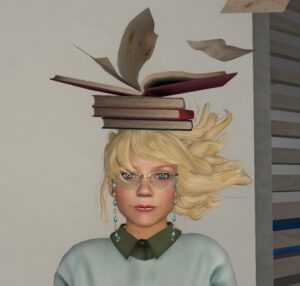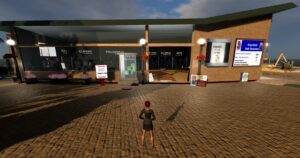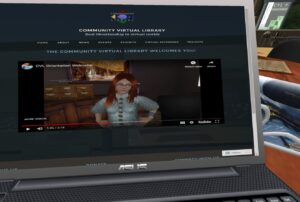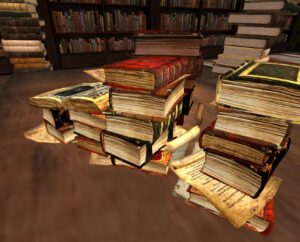
Libraries were magic places when I was a child. I walked to several neighborhood public libraries all the time and loved to search out interesting stories from the slightly musty shelves. My grammar school only let us into the library once a week and the librarian made us feel like death awaited if we failed to return our three books in perfect condition and on time.
Throughout my life, the magic of searching the shelves for the right book has never faded. Libraries have changed. The card catalog has been computerized and scientific journals are available on my laptop and phone. Books arrive on my Kindle viewer.

Naturally digital libraries are found in Second Life®. I asked Valibrarian Gregg, the Director of the Community Virtual Library to tell me about the history and future of libraries without physical books. Valibrarian (in RL, Valerie Hill, Ph.D.) got involved in virtual worlds and on-line libraries back in the early days of SL.
“In 2006, I read about the American Library Association creating a virtual library presence in Second Life. I created and avatar and entered the virtual world to connect with other librarians. At that time, there were many educators and librarians exploring virtual worlds and the excitement was high! Unfortunately, the steep learning curve and the rise of social media and quick “apps” overtook educational technology trends. Many educators left SL when the discount for education ended in 2010.
“Those like me who found benefits and advantages for teaching, learning, and collaborating across the globe in virtual worlds have remained committed. The sustainable learning spaces in SL provide a place for continued learning alone or in a community when entered purposefully. These spaces have potential for deep thinking and learning beyond the “disposable” apps found on most digital devices.

“The Community Virtual Library (CVL) has been a hub for librarians since 2006, networking with public, academic, school and special libraries both in the physical and virtual world. For example, the Caledon Library partners with CVL for a monthly literary study. Information literacy experts, like Sheila Webber collaborate with CVL. The Association of College and Research Libraries Virtual World Interest Group meet at CVL monthly to provide virtual programs.”
I wondered what tangible product have grown from these in-world collaborations. Valibrarian has been involved in a number of interesting projects.
“Virtual world exhibits and field trips to immersive learning environments, such as Math in 3D, the Alamo, a virtual tornado, Summer in Berlin and many more have provided rich learning experiences that cannot be experienced in the physical world.
“Our Digital Citizenship Museum in Kitely presents concepts that impact all of us in digital culture such as digital legacy, cybersecurity, artificial intelligence, etc.
“CVL contributes a research center every year at the Dickens Project in December.
“Connecting virtual world communities, such as ISTE, the Virtual Pioneers, the Nonprofit Commons, Rockcliffe University, and Caledon Oxbridge University, has been high priority for CVL.
“Current projects include a Hypergrid Resource Center in Kitely, a virtual world database online, and a partnership with the Antique Pattern Library (New Media Arts, Inc) to advocate historical authenticity.”

I know from my personal experience how difficult the move from the physical world into the digital can be and so I wondered what were the hurdles to be overcome in providing virtual library services? She said that advocating the benefits of virtual worlds has been a challenge and summarized a few of them.
“Investigating best practices for virtual learning environments has been my passion for over a decade. My doctoral dissertation was “Factors Contributing to the Adoption of Virtual Worlds by Librarians.” My research concluded that virtual worlds align well to librarianship but are currently ‘too complex’ for mainstream adoption.
“Navigating online environments for information literacy in digital culture brings challenges to us all – from early childhood through old age. Teaching “metaliteracy” (literacy in digital culture) is essential in virtual worlds but also in physical spaces because whether or not one has an avatar, we all live in digital culture with 24/7 access to global in formation. The library is in our pocket – on our smart phone.
“The biggest hurdle we face is teaching digital citizenship since the quick rise in networked culture has brought a flood of information nonstop, the death of privacy, a need for cybersecurity, and questions about accuracy in a post-truth era. Librarians are trained to help teach information literacy and a virtual world is the perfect place… yet SL is still too difficult for many teachers and they do not have enough time to learn the interface.
“The next generation, however, seems ready for virtual worlds! Even young children are using Minecraft to build 3D content. So, I remain hopeful that virtual spaces will be used for high level learning – not simply to kill zombies!”
So, as we wait for the next generation of digital humans to become scientists, I wondered what virtual worlds can offer them. Valibrarian is very enthusiastic about the possibilities.
“Metaliteracy is ‘thinking about literacy’ since the changes brought on by the Internet and online connectivity. Digging deep into critical inquiry by learning how to evaluate and juggle numerous technology tools is not easy. In fact, CVL will soon be offering a Symbolic Modeling of Metaliteracy session, where participants can use 3D objects to build models of the process of research and information literacy. Through symbolic modeling, one can develop a personal understanding of their own metaliteracy and the feelings they have toward it – including frustration, confirmation bias, anxiety, etc.
 “The Internet and networked culture has rapidly changed learning and literacy. Developmental psychologists are studying how children’s brains have changed with the technology tools and devices that surround them. Reading specialist, MaryAnne Wolf, believes children are developing a ‘bilterate brain’ capable of switching between virtual (digital) modes and physical modes. Her book ‘Dear Reader Come Home: the Reading Brain in a Digital World’ shares numerous examples of metaliteracy and suggests that very young children limit time on digital devices and spend time with a role model sharing books in print.
“The Internet and networked culture has rapidly changed learning and literacy. Developmental psychologists are studying how children’s brains have changed with the technology tools and devices that surround them. Reading specialist, MaryAnne Wolf, believes children are developing a ‘bilterate brain’ capable of switching between virtual (digital) modes and physical modes. Her book ‘Dear Reader Come Home: the Reading Brain in a Digital World’ shares numerous examples of metaliteracy and suggests that very young children limit time on digital devices and spend time with a role model sharing books in print.
“As for the intersection of science and virtual libraries, let me add… Virtual worlds provide a space to experience scientific concepts that cannot be done in the real world. Examples include entering the human body, exploring space, going through a hurricane, entering a volcano, etc. Just as in a physical world library, librarians can help people find these experiences as resources. This need may grow even bigger in the future.”
For Further Reading
- Hill, V., Vans, M. & Dunavant-Jones, A. (2018). Virtual Worlds Database: A Tool for Connecting Metaverse Communities. Virtual Education Journal, Summer 2018, 66-75. Retrieved from https://issuu.com/edovation/docs/vej_summer_2018
- Vans, M., Hill, V. & Dunavant-Jones, A. (2018). Improving Digital Literacy: a Solvable Challenge Using Virtual Worlds. Journal of Virtual Studies 9(2), 14-24.
- Hill, V. (2018). Digital Citizenship through Immersive Learning. Journal of Virtual Studies 9(3), 16-22).
- Hill, V. J. & Knutzen, K.B., (2017) Virtual World Global Collaboration: an Educational Quest, Information and Learning Science, 118 (9/10), 547-565.
- Hill, V., Vans, M., & Dunavant-Jones, A. (2017). Metaverse libraries: Communities as resources. Journal of Virtual Studies 8(2), 27-37.
- Hill, V. J. (2017). Digital Citizenship in Participatory Culture. In A. Stricker, C. Calongne, B. Truman, & F. Arenas (Eds.), Integrating an Awareness of Selfhood and Society into Virtual Learning (pp. 60-73). Hershey, PA: IGI Global.
- Hill, V. (2016). The Community Virtual Library: A Decade of Virtual World Librarianship. Virtual Education Journal, Spring 2016, 53- 57. Retrieved from https://issuu.com/edovation/docs/vej_s_2016_mag_upload_opt
- Hill, V. J. (2016). The Future of Libraries in the Digital Age. In P. Franks, L. Bell, & R. Trueman (Eds.) Teaching and Learning in Virtual Environments: Archives, Museums and Libraries. (pp.225-235). Hershey, PA: Information Science Reference. Santa Barbara, CA: Libraries Unlimited.
- Hill, V. J. (2016). Information Literacy in Virtual Environments: Changing Needs of P-12 Learners. In D. Russell, & J. Laffey (Eds.) Handbook of Research on Gaming Trends in P-12 Education (pp. 165-177). Hershey, PA: Information Science Reference.
- Hill, V. and Brock-Richmond, R., (2015). Exemplifying Professional Avatar Creation through Hermeneutic Phenomenology. Journal of Virtual Studies, (6) 3, 7-23.
- Hill, V. (2015), Digital Citizenship Through Game Design in Minecraft. New Library World. 116 (7/8).
- Valibrarian’s e-portfolio
 |
| 2 |
Fashion note: In the photo, Deepy is wearing the Desire dress from LUXE Paris. The dress is a lot more daring from the front but since this is a PG blog I showed the back view only.
Visits: 2
